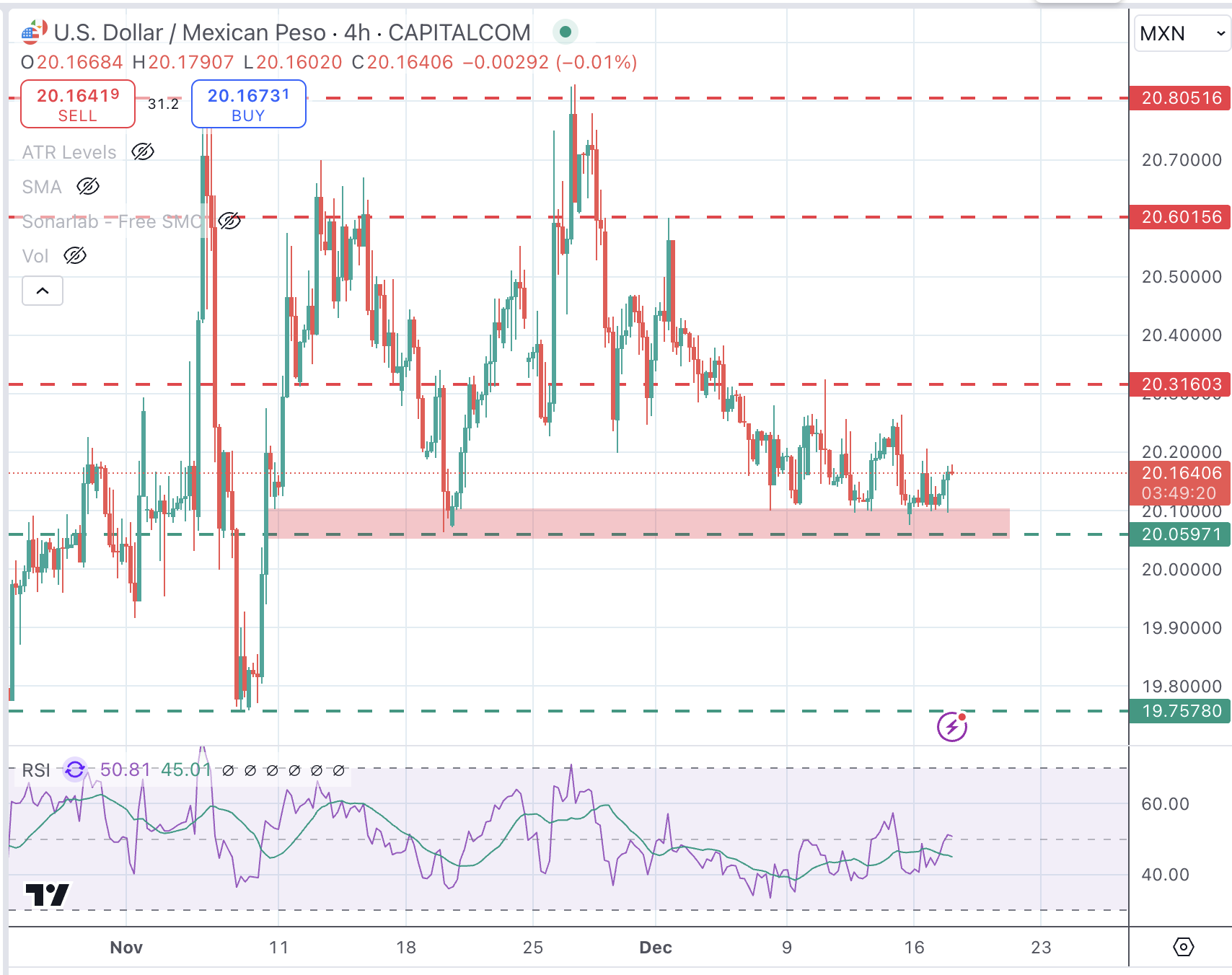- The Mexican is drifting away from the 20.00 level with the Dollar buoyed by the positive US Retail Sales figures.
- Recent US data has boosted speculation that the Fed will adopt a hawkish stance after cutting rates on Wednesday.
- From a wider perspective, USD/MXN is on a bearish trend but needs an extra boost to breach the 20.00 level.
The Mexican Peso (MXN) is trading lower on Tuesday, pulling back from 20.00 level against the US Dollar (USD). A higher-than-expected increase in US Retail Sales data has confirmed the positive outlook of the US economy bolstering the case for a hawkish Federal Reserve (Fed) statement on Wednesday.
Today's consumption figures come after an unexpected improvement in the preliminary S&P Global Purchasing Managers Index (PMI) data released on Monday. Services sector activity expanded at its fastest pace in three years, suggesting that the US economy will close the year on a strong note.
With these figures in mind, and with the latest inflation reports reflecting higher price pressures, investors have pared back their expectations of Fed rate cuts for 2025. Mexican dat, on the contrary, has disappointed. Figures released on Tuesday showed that Retail Sales declined against expectations in October, cementing hopes that the Bank of Mexico will cut rates on Thursday.
Daily digest market movers: US Dollar remains steady ahead of the Fed meeting
- The US Dollar Index (DXY) trades higher on Tuesday, approaching multi-week highs amid higher US Treasury yields and market expectations of a “hawkish cut” by the Fed on Wednesday.
- US Treasury yields keep marching higher. The Benchmark 10-year yield has breached the 4.40% level in a 7-day rally after bouncing at 4.13% early last week.
- US Retail Sales increased by 0.7% in November, beyond expectations of a 0.5% increment. October's sales have been revised up to 0.5% from the 0.4% previously estimated. Excluding cars, sales of all other items have risen 0.2%, below the 0.4% expected and following an upwardly revised 0.2% reading on the previous month.
- Mexican Retail Sales dropped 0.3% in October, against market expectations of a 0.2% increase, following a 0.1% uptick in September. The impact on the pair, however, has been muted.
- The US preliminary Services PMI jumped to 58.5 in December, its best performance in more than three years, from 56.1 in November, against expectations of a moderate slowdown to 55.7.
- US preliminary Manufacturing PMI contracted to 48.3 from 49.7 in November, but the composite data points to healthy economic growth in the last quarter of the year.
- Later today, US Retail Sales are expected to have increased by 0.5% in November, up from 0.4% in the previous month. Excluding autos, consumption is seen accelerating at a 0.4% pace from 0.1% in the previous month.
- The CME FedWatch tool shows a 25 bps interest rate cut by the Fed on Wednesday is almost fully priced in, and the market expects one or two more such cuts next year.
- The Bank of Mexico is expected to lower interest rates by 25 basis points on Thursday, to a 10.00% rate, amid growing concerns that the increasing tariffs in the US will hit the Mexican economy.
US Dollar PRICE Today
The table below shows the percentage change of US Dollar (USD) against listed major currencies today. US Dollar was the strongest against the Australian Dollar.
| USD | EUR | GBP | JPY | CAD | AUD | NZD | CHF | |
|---|---|---|---|---|---|---|---|---|
| USD | 0.00% | -0.19% | -0.32% | 0.16% | 0.23% | 0.22% | 0.05% | |
| EUR | -0.00% | -0.18% | -0.34% | 0.15% | 0.23% | 0.21% | 0.05% | |
| GBP | 0.19% | 0.18% | -0.16% | 0.33% | 0.43% | 0.39% | 0.25% | |
| JPY | 0.32% | 0.34% | 0.16% | 0.48% | 0.56% | 0.52% | 0.40% | |
| CAD | -0.16% | -0.15% | -0.33% | -0.48% | 0.08% | 0.06% | -0.08% | |
| AUD | -0.23% | -0.23% | -0.43% | -0.56% | -0.08% | -0.03% | -0.19% | |
| NZD | -0.22% | -0.21% | -0.39% | -0.52% | -0.06% | 0.03% | -0.14% | |
| CHF | -0.05% | -0.05% | -0.25% | -0.40% | 0.08% | 0.19% | 0.14% |
The heat map shows percentage changes of major currencies against each other. The base currency is picked from the left column, while the quote currency is picked from the top row. For example, if you pick the US Dollar from the left column and move along the horizontal line to the Japanese Yen, the percentage change displayed in the box will represent USD (base)/JPY (quote).
Mexican Peso technical outlook: USD/MXN has strong support at the 20.00 area
The USD/MXN is trading lower from its late November highs near 20.80, but the 20.00 psychological level keeps holding downside attempts. The pair has been consolidating between the mentioned 20.00 support and 20.30 for the last seven trading days.
The Mexican Peso would need an additional impulse to breach the 20.00 level against the US Dollar and shift its focus toward the October 24 and 25 and November 7 lows, at 19.75
On the upside, the USD/MXN needs to confirm above 20.30 before aiming for the December 2 high at 20.60 and November’s peak at around 20.80.
USD/MXN 4-Hour Chart
Fed FAQs
Monetary policy in the US is shaped by the Federal Reserve (Fed). The Fed has two mandates: to achieve price stability and foster full employment. Its primary tool to achieve these goals is by adjusting interest rates. When prices are rising too quickly and inflation is above the Fed’s 2% target, it raises interest rates, increasing borrowing costs throughout the economy. This results in a stronger US Dollar (USD) as it makes the US a more attractive place for international investors to park their money. When inflation falls below 2% or the Unemployment Rate is too high, the Fed may lower interest rates to encourage borrowing, which weighs on the Greenback.
The Federal Reserve (Fed) holds eight policy meetings a year, where the Federal Open Market Committee (FOMC) assesses economic conditions and makes monetary policy decisions. The FOMC is attended by twelve Fed officials – the seven members of the Board of Governors, the president of the Federal Reserve Bank of New York, and four of the remaining eleven regional Reserve Bank presidents, who serve one-year terms on a rotating basis.
In extreme situations, the Federal Reserve may resort to a policy named Quantitative Easing (QE). QE is the process by which the Fed substantially increases the flow of credit in a stuck financial system. It is a non-standard policy measure used during crises or when inflation is extremely low. It was the Fed’s weapon of choice during the Great Financial Crisis in 2008. It involves the Fed printing more Dollars and using them to buy high grade bonds from financial institutions. QE usually weakens the US Dollar.
Quantitative tightening (QT) is the reverse process of QE, whereby the Federal Reserve stops buying bonds from financial institutions and does not reinvest the principal from the bonds it holds maturing, to purchase new bonds. It is usually positive for the value of the US Dollar.
Information on these pages contains forward-looking statements that involve risks and uncertainties. Markets and instruments profiled on this page are for informational purposes only and should not in any way come across as a recommendation to buy or sell in these assets. You should do your own thorough research before making any investment decisions. FXStreet does not in any way guarantee that this information is free from mistakes, errors, or material misstatements. It also does not guarantee that this information is of a timely nature. Investing in Open Markets involves a great deal of risk, including the loss of all or a portion of your investment, as well as emotional distress. All risks, losses and costs associated with investing, including total loss of principal, are your responsibility. The views and opinions expressed in this article are those of the authors and do not necessarily reflect the official policy or position of FXStreet nor its advertisers. The author will not be held responsible for information that is found at the end of links posted on this page.
If not otherwise explicitly mentioned in the body of the article, at the time of writing, the author has no position in any stock mentioned in this article and no business relationship with any company mentioned. The author has not received compensation for writing this article, other than from FXStreet.
FXStreet and the author do not provide personalized recommendations. The author makes no representations as to the accuracy, completeness, or suitability of this information. FXStreet and the author will not be liable for any errors, omissions or any losses, injuries or damages arising from this information and its display or use. Errors and omissions excepted.
The author and FXStreet are not registered investment advisors and nothing in this article is intended to be investment advice.
Recommended content
Editors’ Picks

Gold clings to gains around $3,430
Gold fell from its previous record high of $3,500 per troy ounce, as overbought indications and a comeback in the US dollar appear to have led purchasers to take a break. Meanwhile, all eyes are on the Trump-Powell frenzy and impending Fed officials' statements.

EUR/USD trims losses, retargets 1.1500 and beyond
EUR/USD now bounces off daily troughs near 1.1460 and refocuses back on the 1.1500 barrier amid some humble knee-jerk in the US Dollar. In the meantime, markets remain cautious in light of President Trump’s criticism of Fed Chair Jerome Powell and its potential implications for the US markets.

GBP/USD treads water below 1.3400
GBP/USD is trading in a narrow zone below the 1.3400 level as the Greenback's solid comeback gains traction on Tuesday. However, continuing concerns about a US economic downturn and misgivings about the Fed's independence are anticipated to limit Cable's downside risk.

3% of Bitcoin supply in control of firms with BTC on balance sheets: The good, bad and ugly
Bitcoin disappointed traders with lackluster performance in 2025, hitting the $100,000 milestone and consolidating under the milestone thereafter. Bitcoin rallied past $88,000 early on Monday, the dominant token eyes the $90,000 level.

Five fundamentals for the week: Traders confront the trade war, important surveys, key Fed speech Premium
Will the US strike a trade deal with Japan? That would be positive progress. However, recent developments are not that positive, and there's only one certainty: headlines will dominate markets. Fresh US economic data is also of interest.

The Best brokers to trade EUR/USD
SPONSORED Discover the top brokers for trading EUR/USD in 2025. Our list features brokers with competitive spreads, fast execution, and powerful platforms. Whether you're a beginner or an expert, find the right partner to navigate the dynamic Forex market.




